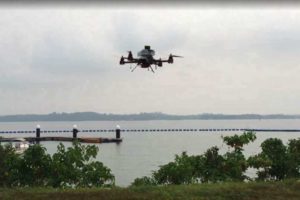 Singapore’s leading homeland security agency is looking to the unmanned skies to bolster security efforts within its borders. Some analysts, however, warn that such a move not be taken lightly.
Singapore’s leading homeland security agency is looking to the unmanned skies to bolster security efforts within its borders. Some analysts, however, warn that such a move not be taken lightly.
In a recent report, Eurasia Review analyst Muhammad Faizal bin Abdul Rahman reported that the city nation’s parliament is debating the use of UAVs and that the Singapore Home Team may use drones “to support the management of public order and major incidents.”
Bin Abdul Rahman warns that the plan should be “accompanied by clear guidelines and with public trust.”
“Is our Singapore public ready for the Big Brother in the sky?” the analyst wonders.
The potential use of security drones is a key part of Singapore’s SG Secure initiative designed to “better engage the community and strengthen its vigilance and resilience.” bin Abdul Rahman, a Singaporean, agrees that an aerial addition to his nation’s security efforts could save lives and enhance public safety. He writes:
“The benefits of surveillance drones to the homeland security are manifold; including increased police presence to deter terrorism and crime, and enhanced data collection for situational assessment to support incident management. In extreme and perilous public order situations, drones could possibly be armed with non-lethal weapons such as tear gas to aid ground officers in dispersing rioters.”
Public surveillance technology is nothing new for Singapore — CCTV cameras can be found on virtually every street corner. However, officials see small drones as less invasive and less visible to the public and hope such a discreet security solution will “not misconceived as a mass surveillance tool for an authoritarian state.”
Abdul Rahman warns that drones should not be used as a substitute for face-to-face interaction between the public and police officers, pointing out that many see drones as “an impersonal and cold connection” from a technology that is perceived – thanks to movies and television – “as faceless killing machines.”
“As an unmanned vehicle, there would be a hidden human operator actively controlling the drone by remote, and this might raise concerns over possible abuse or misuse,” he adds.
While the government wrestles with police drone possibilities, the nation has found other uses for unmanned tech. Last year, Singapore’s largest postal carrier signed an agreement with the government to launch drone mail delivery.
In October, SingPost completed a trial run for a delivery drone between the towns of Lorong Halus and Pulau Ubin.
Using a SteadiDrone platform, coupled with a Pixhawk guidance system, the drone project was launched under the auspices of a joint agreement between SingPost and the nation’s government-funded tech lab, the Infocomm Development Authority of Singapore (IDA).
Jason is a longstanding contributor to DroneLife with an avid interest in all things tech. He focuses on anti-drone technologies and the public safety sector; police, fire, and search and rescue.
Beginning his career as a journalist in 1996, Jason has since written and edited thousands of engaging news articles, blog posts, press releases and online content.
Email Jason
TWITTER:@JasonPReagan
Subscribe to DroneLife here.







Leave a Reply